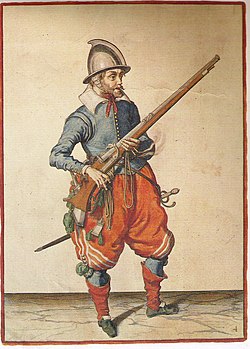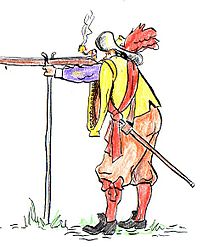Musketeer


A musketeer (French: mousquetaire) was a type of soldier equipped with a musket. Musketeers were an important part of early modern warfare, particularly in Europe, as they normally comprised the majority of their infantry. The musketeer was a precursor to the rifleman. Muskets were replaced by breech loading rifles as the almost universal firearm for modern armies during the period 1850 to 1870. The traditional designation of "musketeer" for an infantry private survived in the Imperial German Army until World War I.
Asia


Han East Asia
The
Indian Sub-continent
Europe
Spain

In the
France

The
As one of the junior units in the Royal Guard, the Musketeers were not closely linked to the royal family. Traditional bodyguard duties were in fact performed by the
Their high esprit de corps gained royal favor for the Musketeers, and they were frequently seen at court and in Paris. Shortly after their creation,
In terms of recruitment, entry into the Musketeers was much sought after by those sons of the aristocracy who did not possess the quarterings of nobility required for the Garde du Corps and Chevau-legers.[14] These two senior guard units were closed to all but the highest ranking and wealthy noble families. Accordingly for lesser gentry, or ambitious commoners, service in the Musketeers was the only way to join a mounted unit in the royal household and perhaps catch the King's eye. However, enlistment did require both letters of recommendation and evidence that a recruit had the family means to support the costs of service. These included the provision of horses, swords, clothing, a servant and equipment. Only the musket, the sleeveless soubreveste and the distinctive blue cassock were provided by the monarch.[15]
In 1776, the Musketeers were disbanded by
Decades later, starting in 1844, this group was the subject of the now-famous serial publication
Other Musketeers include:
- Bénigne Dauvergne de Saint-Mars (died 1708), better known as the jailor of the Man in the Iron Mask
- Pierre de Montesquiou d'Artagnan (1640–1725), later a Marshal of France
- Jean-François Leriget de La Faye (1674–1731)
- Louis de Rouvroy, duc de Saint-Simon (1675–1755)
- Germain-François Poullain de Saint-Foix (1698–1776), later a writer and playwright
- Thomas de Treil de Pardailhan (1754–1822)
- François-Henri de Franquetot de Coigny (1737–1821), later a Marshal of France
- Alexandre de Beauharnais (1760–1794), first husband of the future Empress Josephine
- Charles Sevin de Quincy (1660-1738), sous-brigadier des mousquetaires noirs (1689), later lieutenant-general and historian
Sweden
Britain

The iconic musket carrying "
The term "musketeer" was rarely used in the titles of regiments. Examples include the 106th Regiment of Foot (Black Musqueteers), the 110th Regiment of Foot (Queen's Royal Musqueteers) and the 112th Regiment of Foot (King's Royal Musqueteers), all raised and disbanded in the 1760s.
The musket was withdrawn from service with the British Army in 1854, replaced by the muzzle-loading Minié rifle, which had an accurate range of over three times that of the Brown Bess which it replaced.[18]
Eurasia
Ottoman Empire

The
Russia
Streltsy (

The first streltsy units were created by
The Muscovite government was chronically short of cash so that the streltsy were often not paid well. While "entitled" to something like four rubles a year in the 1550s, they were often allowed to farm or trade in order to supplement their incomes. Textiles for clothing and foodstuffs were sometimes issued as part of their pay. A commander of one hundred musketeers (sotnik) received up to 20 roubles a year and a regimental head (streletski golova) between 30 and 60.[22]
In the late 17th century, the Streltsy of Moscow began to actively participate in a struggle for power between different government groups, supporting dissidents and showing hostility towards any foreign innovations.[23]
After the fall of
Gradually, the streltsy were incorporated into the regular army. At the same time, the Tsarist government started to disband the Municipal Streltsy. Liquidation of the last streltsy units (by then social rather than military groups) was finally completed by 1728.[26]
The
Africa
A small musketeer force was authorized in Kongo mostly made up of the mestiço, who were mixed race Kongolese with Portuguese ancestry. Over 300 musketeers served in the Kongo army against the Portuguese at the Battle of Mbwila in 1665.[28][29] Musketeers were employed into the Wydah army from 1680 AD but they did not completely replace the spearmen, swordsmen and archers. In war, the Musketeers were first to go into action as they fought in the front ranks of the army.[30]
See also
- Fusilier
- Rifleman
- Pike and shot
- Line infantry
- Foot Guards
Gallery
-
Musketeer from Altblau regiment (1624–1650) from Swedish army with musket and with bardiche (long poleaxe)
-
18th-century musketeers from Świdnica (reconstruction).
References
- ^ Chase 2003, p. 141.
- ^ Needham, Volume 5, Part 7, 447–454.
- ^ Needham, Volume 5, Part 7, 449–452.
- ISBN 0-521-30358-3.
makes its appearance, but now alongside all kinds of more modern things, such as mobile armoured shields for field-guns, bullet-moulds and muskets, and even a kind of primitive machine-gun. b The fire-lance was not yet quite dead
- ISBN 962-209-188-1.
Once again the li hua ch'iang makes its appearance, but now alongside all kinds of more modern things, such as ... for field-guns, bullet moulds, and muskets, and even a kind of primitive machine- gun.96 The fire-lance was not yet quite
- ISBN 978-0-7566-4219-8.
- ISBN 1-85532-344-3.
- ISBN 979-8429737126.)
{{cite book}}: CS1 maint: location missing publisher (link - ISBN 979-8429737126.)
{{cite book}}: CS1 maint: location missing publisher (link - ^ Parker, Geoffrey (1972). The Army of Flanders and the Spanish Road. Cambridge University Press. p. 274.
- ISBN 9781780968612.
- ISBN 978-1-78096-861-2.
- ISBN 9781780968612.
- ISBN 978-1-78096-861-2.
- ISBN 978-1-78096-861-2.
- ISBN 978-1-78096-861-2.
- ISBN 978-1-78096-861-2.
- ^ R. M. Barnes, A History of the Regiments & Uniforms of the British Army, Sphere Books, p. 95.
- ISBN 1-85532-413-X.
- ISBN 1-84176-925-8.
- ISBN 1-84176-925-8.
- ISBN 1-84176-925-8.
- ISBN 1-85532-315-X.
- ISBN 978-0809464586.
- ISBN 1-85532-315-X.
- ISBN 1-84176-925-8.
- ISBN 1-85532-315-X.
- JSTOR 2164997.
- S2CID 144152478.
- S2CID 163027192.
Sources
- Chase, Kenneth Warren (2003). Firearms: A Global History to 1700 (illustrated, reprint ed.). Cambridge University Press. ISBN 0521822742.
- Needham, Joseph; et al. (1986). Science and Civilisation in China. Vol. 5, Part 7 Military Technology: The Gunpowder Epic. New York: Cambridge University Press.













